- Banned
- #681
That just might be the most important revelation of this thread!Love it, page 34 and we’ve added bra size/eq ratio for evaluating women as a yet another subjective to subjective comparison.
Certainly there’s no problem.
Follow along with the video below to see how to install our site as a web app on your home screen.
Note: This feature may not be available in some browsers.
That just might be the most important revelation of this thread!Love it, page 34 and we’ve added bra size/eq ratio for evaluating women as a yet another subjective to subjective comparison.
Certainly there’s no problem.
Since energy is a calculation based on mass and velocity why is it not relevant? Obviously all you need is 556 foot pounds of energy and a 77 grain bullet that flies apart inside of 12 inches of penetration. Again obviously this is more effective than a 150 grain bullet going 1800 fps that creates a 3 inch wide wound channel for 10 inches and gets 26" of penetration with an expanded diameter of .580. That is what 1090 foot pounds of energy looks like with a controlled expanding bullet from a 30-30.
My next experiment is going to be a 110 grain CX designed for the Blackout going 3150 fps from a 308. Gives me everything, large fragments moderately good penetration. A bang flop happens often with average cup and core bullets going average velocities. It happens pretty often with bullets starting out at more than 3000 fps. And it happens with fragmenting bullets at various speeds also. I don't really care if an animal runs 50 yards before it drops, it is nice when the heart is still pumping blood while doing so and remains edible.If we were to overlay your example on the graph i put in my Wallop thread this would make sense. KE is great but if there is not sufficient transfer of KE of the bullet into the target vitals, the chance of lethality goes down.
Also if your KE is transferred immediately your bullet will 'splash' on target and only maim the quarry. Hence why bullet construction is so important. Again if you look at the graph posted you'll notice that both ideal bullet and non ideal bullet are not making contact at 0 engergies. They have to hit with enough energies to penetrate, but if the energies expended over distance is not a steep parabolic like curve, the wound channel won't be big enough
Right now i'm currently debating which bullet is best because I'm not a fan of additional lead in my dinner. I've had great success with ELDM and ELDX in 7mm flavor. I've shot 1 deer with and ELDM and 1 with ELDX, both were full pass thru with golf ball exits. The ELDM was a 110 yard shot with a 45ish yard run The ELDX was a 204 yard shot but it was a BangFlop A friend of mine shoots a lot of Bergers, and shoots more animals than I do. He is all in on smaller calibers, but prefers a "bang flop" like anyone else. His opinion on Bergers has fallen. I've told him that he should move to ELDX or ELDM but he's probably just gonna move to a 6.5 caliber
Energy can only roughly calculate how big or small the "hole" is. With soft bullets you get big wide holes, with hard bullets you get narrower and longer holes. If both have the same energy then theoretically the volume of the "hole" will be the same. I tend to believe though that a larger bullet would have slightly larger volume than a smaller bullet with the same energy simply because the heavier bullet would either have more mass to fragment or more weight to penetrate.Imho this is why energy is not a good indicator of performance (aka irrelevant), all three bullets do the same work on the animal, but starting energy is different. In the end it’s a function of the bullet, not energy.
Sort of, but to add to why energy doesnt correlate to wound size:Energy can only roughly calculate how big or small the "hole" is. With soft bullets you get big wide holes, with hard bullets you get narrower and longer holes. If both have the same energy then theoretically the volume of the "hole" will be the same. I tend to believe though that a larger bullet would have slightly larger volume than a smaller bullet with the same energy simply because the heavier bullet would either have more mass to fragment or more weight to penetrate.
You are sort of proving my point. It’s the bullet that determines the hole size, not the kinetic energy available. Big soft bullets going fast do lots of damage, yet a big fmj going fast doesn’t and a small soft bullet going fast can do a lot of damage as well, not as much as a bigger one for sure.Energy can only roughly calculate how big or small the "hole" is. With soft bullets you get big wide holes, with hard bullets you get narrower and longer holes. If both have the same energy then theoretically the volume of the "hole" will be the same. I tend to believe though that a larger bullet would have slightly larger volume than a smaller bullet with the same energy simply because the heavier bullet would either have more mass to fragment or more weight to penetrate.
The bullet determines the hole's shape not size. The amount of energy available determines the size.You are sort of proving my point. It’s the bullet that determines the hole size, not the kinetic energy available. Big soft bullets going fast do lots of damage, yet a big fmj going fast doesn’t and a small soft bullet going fast can do a lot of damage as well, not as much as a bigger one for sure.
A bullet needs energy to pass through. If it has enough energy to pass through and make a 1 1/2" exit hole then as far as I am concerned I don't care how much energy wasn't imparted to the animal, there was enough.Sort of, but to add to why energy doesnt correlate to wound size:
1) Passing thru=energy not doing work. Whatever energy is still carried by the bullet as it passes thru can no longer be transferred to making a hole in the critter. A passthru is the definition of transferring less than 100% of the possible energy into making the wound.
2) the RATE of energy transfer determines the peak force or f max placed on the tissue. Its the equivalent of being in a car at 60mph, and either slamming into a concrete bridge abutment (60 to 0 in .01 seconds, extremely high rate of energy transfer), versus gently applying the brakes over a couple hundred feet (60 to 0 in 20 seconds, slow energy transfer). Same amount of energy…which one do you feel on your seatbelt more? This rate of transfer has a lot to do with the size of both the temporary and permanent portions of the wound. This is not the impact velocity, this is differences in bullet upset in tissue causing it to lose velocity (ie transfer the energy) at different rates, measured in tiny fractions of a second…tiny differences matter a lot in this case because it exponentially affects the peak force applied to the tissue around the bullet. Peak force and total force are very different.
3) an additional wounding mechanism (bullet fragments cutting stretched tissue during the temporary stretch cavity) is not energy-based, the same way an arrow cutting thru tissue is not energy-based.
Id agree it was enough, the question is whether the amount of energy tells us anything at all useful to achieving that. If total quantity of energy is important to know, let us know how much energy it takes to pass thru a deer.A bullet needs energy to pass through. If it has enough energy to pass through and make a 1 1/2" exit hole then as far as I am concerned I don't care how much energy wasn't imparted to the animal, there was enough.
There is something missing in your comment. Logic. Without energy there is no function by the bullet.Imho this is why energy is not a good indicator of performance (aka irrelevant), all three bullets do the same work on the animal, but starting energy is different. In the end it’s a function of the bullet, not energy.
The bullet's construction decides how much it penetrates or doesn't. A bullet can use up it's calculated energy by expanding dramatically which limits penetration, or as in a good controlled expanding bullet blending expansion and penetration to get both destruction and exits. It is idiocy not to consider bullet construction in the application of calculated energy. A bullet is in itself inert. It does not add to calculated energy numbers because it deforms. It applies the energy it has in the way it is constructed to apply it.Id agree it was enough, the question is whether the amount of energy tells us anything at all useful to achieving that. If total quantity of energy is important to know, let us know how much energy it takes to pass thru a deer.
Or is it dependent on other variables? If so that proves my point. A 55gr 223 fmj has “enough” energy to pass thru. Need a 1.5” exit, thats what ive seen from a 6.5cm shooting a bonded lead bullet. But I’ve seen several non pass thru’s from a 3006 shooting 165gr sst’s. Must not be enough energy?
Correct, but thats not the question. The question is whether calculated total energy ALONE is predictive of the size of a wound. It’s not. The point is that the application is very relevant, while the total amount of calculated energy is far less relevant.It is idiocy not to consider bullet construction in the application of calculated energy.
Perhaps before it hits anything. Once it hits something, the interaction of that bullet and whatever it hits becomes much more relevant and complex.A bullet is in itself inert.
This is the key. While this statement may be correct, its missing the point entirely, because it equates the raw calculated energy with the energy transferred into creating the wound, which are two completely different calculations not based on the same criteria. Its kinetic energy versus impact force. The quoted statement entirely misses the concept of peak impact force as measured on the target. Kinetic energy and impact force are not the same. This is the car crash versus slow controlled stop I referenced earlier—same total energy, but when it comes to the force TIME is a major component of the calculation. The force felt on your body from the seat belt is based on the duration of time that it takes to apply the same amount of energy, which RADICALLY increases or decreases the peak force felt on your body. In this analogy, 60mph is the muzzle velocity, the total energy is the mass of the car combined with the speed, but the different damage to your body is based far more on how long it takes to stop than it is on the total amount if energy, which is analogous to how a bullet upsets. The slow braked stop is like a bullet that penetrates deep with a narrower wound, while the crash is analogous to a fragmenting bullet that loses velocity faster. It is a fact that if you drive a prius into a bridge abutment at 60mph you are likely to be injured, while a slow controlled stop of your f-250 from 90mph is gentle. Its the speed of deceleration that creates a HIGHER peak force in the prius crash despite there being muuch less total energy involved.It does not add to calculated energy numbers because it deforms. It applies the energy it has in the way it is constructed to apply it.
Here's what chatGPT has to say about it:google search link
Kinetic energy and impact force, while related in the context of a bullet, are distinct concepts. Kinetic energy is the energy of motion, while impact force is the force applied during the collision of the bullet with a target. The bullet's kinetic energy determines the potential for damage, while the impact force is the actual force exerted during the collision, influenced by factors like target material and bullet deformation.
Kinetic Energy:
Impact Force:
- Definition:
Kinetic energy (KE) is the energy possessed by an object due to its motion. It's calculated as KE = 1/2 * mass * velocity^2.
- Bullet's KE:
A bullet's kinetic energy is determined by its mass and velocity. Higher velocity and mass result in greater kinetic energy.
- Impact:
When a bullet strikes a target, its kinetic energy is transferred to the target, causing deformation, penetration, and potentially causing damage.
Key Differences:
- Definition:
Impact force is the force exerted during a collision. It's the rate at which momentum is transferred during the impact.
- Target Material: Harder targets will result in a higher impact force over a shorter time, while softer targets will absorb more energy and distribute the force over a longer time.
- Bullet Deformation: How the bullet deforms upon impact influences the force experienced by the target.
- Momentum: Momentum is the product of mass and velocity, and it's conserved during impact. While the total momentum is conserved, the force experienced by the target and the bullet can differ due to the interaction time and target properties.
- Kinetic energy is a scalar quantity (magnitude only), while impact force is a vector quantity (magnitude and direction).
- Kinetic energy is a measure of the potential for damage, while impact force is the actual force applied during the collision.
- Impact force is influenced by how the kinetic energy is transferred and dissipated during the impact, including factors like target material and bullet deformation.
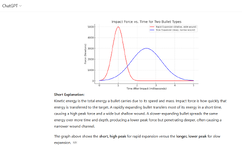
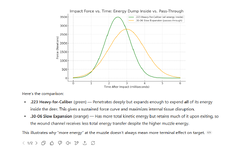
This is exactly what we've been saying about WHY energy is irrelevant. We don't care either. In this case you don't care how much energy WASN'T imparted... and We don't care how much WAS...The formula is simple. Fragmenting bullets travelling greater than 1800 FPS = enough. Shoot 'em in the front half.I don't care how much energy wasn't imparted to the animal, there was enough.
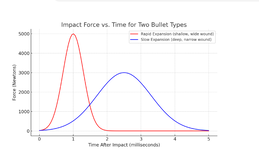
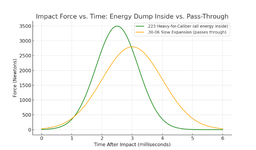
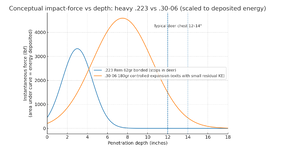
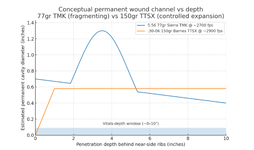
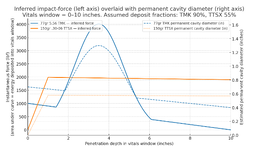
at what impact velocity?, over what swim distance? is one only going 16" while the other goes 32", if so what is the total permanent cavity volume potential for each option then? does it fit our goals intended?
- 77 gr 5.56 TMK → permanent-cavity volume ≈ 4.50 in³
- 150 gr .30-06 TTSX → permanent-cavity volume ≈ 2.41 in³
it's far more dependent on the bullet which determines how energy is applied. Sure, energy is relevant, but that means energy APPLICATION is relevant, it looks an awful lot like energy AMOUNT is more or less meaningless until you specify how it will be applied.
